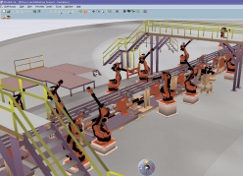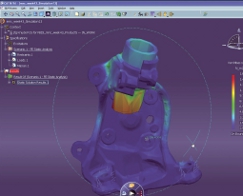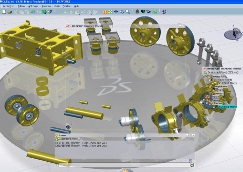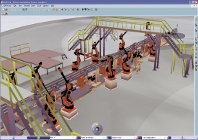Our industry tends to lack showmen and leaders with visible passion but this is something that Dassault Systemes’ (DS) has almost uniquely embodied in its enigmatic CEO, Bernard Charles.
At this year’s Catia developers’ forum in Paris, Charles was on-hand to officially launch the latest generation of the company’s flagship product development system, Catia V6. With an on-stage Virtual Reality backdrop of the company’s under construction purpose-built campus, Charles gave a typically Gallic impassioned address to the audience, as to the innovations that V6 and what he called PLM 2.0 (Product Lifecycle Management) will bring to his customers.
Dassault Systemes has segmented its product areas of interest exceptionally cleanly. Catia, Enovia, Delmia and Simulia are really where it concentrates most of its engineering efforts
There’s probably no CAD company on the planet that has done more to market PLM and the virtue of ‘business process change’ in engineering. In fact, from my experience, all the DS executives seem to live, eat and sleep the PLM message. While this hasn’t always been clearly explained, I do feel that from the emerging company structure and product portfolio, an interesting vision of a total engineering system is certainly taking shape.
Before getting onto V6 and the ‘new new’ and what it will mean to customers, it’s worth going through the relatively new structuring of Dassault Systemes. The company has gone through almost constant change as its PLM vision has developed. This has resulted in a several defined brands and divisions within the company.
CATIA – The core brand is obviously Catia, the company’s 3D product development system that plays a major role in high-end automotive and aerospace design, as well as a number of other significant markets. There’s the full Catia V6 R2009 version as well as Catia PLM Express bundles for small to mid-sized companies.
ENOVIA – The management portion of the company that manages collaboration, product structure and distribution. DS recognises that different industries have their own processes and flows and so has come up with a number of configurations for specific markets (aerospace, footwear and apparel, automotive, consumer packaged goods, semi-conductor etc.). In addition to the all-encompassing management system, Enovia SmarTeam is the management solution DS offers for small to medium companies.

Dassault Systemes’ Delmia brand
DELMIA – Offers a suite of Digital Manufacturing tools to optimise and define manufacturing processes and production. This can be implemented for early process planning and assembly simulation, to modelling welding lines, robot and cell programming. Again DS recognises a number of different market needs and has solutions for Aerospace, Automotive, Shipbuilding and Energy. There’s also a ‘Human’ module to test ease of build, maintenance and operation.
SIMULIA – Was the last Catia-related division and is dedicated to producing realistic simulation and analysis tools for FEA and structural analysis on parts of assemblies (including composite parts). When simulation and analysis is combined with the virtual model, this reduces the need for physical prototypes and therefore cost.

Dassault Systemes Simulia brand
Of course there is another division to DS, that of the highly successful mid-range modeller, SolidWorks, which usually doesn’t get talked about at Catia-related events. SolidWorks occupies the middle-ground of the 3D engineering market and DS mainly sees it as a stick with which to hit Autodesk and its Inventor product. To date there have been very few links between SolidWorks and Catia and hardly any sharing of technology. Both products have different interfaces, different modelling kernels (SolidWorks uses Parasolid which is owned by DS’ rival Siemens PLM Solutions) and go to market through different channels. The big question is how, over time, this might change as the mid-range market matures. With the new CEO of SolidWorks, Jeff Ray seemingly working more closely with DS at its headquarters than his predecessor the first signs of changes have started to creep through, with some new products from DS’ 3DVIA division being sold through SolidWorks dealers.
3DVIA – is the most recent division for Dassault Systemes and its mission is the democratisation of 3D, so that everyone can use it in their day to day lives, in applications or online. This in itself is a very broad area to cover and the product set and technologies the division has are equally diverse: 3DVIA Composer, a desktop authoring system for interactive product documentation (this is the result of acquiring a company called Seemage), 3DVIA Virtools for producing virtual worlds for customer experiences and simulation, 3DVIA MP for games developers and 3D Live, a lightweight 3D application along the lines of SketchUp. The division is also in charge of the 3DXML open format that DS has created.
While that’s a lot to take in, I think DS has segmented its product areas of interest exceptionally cleanly. Catia, Enovia, Delmia and Simulia are really where Dassault concentrates most of its engineering efforts. SolidWorks has been left pretty much to develop and fight its own corner, a task it has done very well. 3DVIA is probably the most ‘fuzzy’ of the divisions, covering such a wide range of 3D application areas. However, 3DVIA is where DS gets to promote the fun, yet commercial, side of 3D repurposing, together with exploring new markets and opportunities outside of the traditional CAD market. One stated objective is also to produce products that can be easily sold over the web, requiring little training.
V6 platform
It seems that V6 has had a number of launches. Looking back I have covered the pre-launch, launch and now the launch to developers – it’s a slow big noise rumbling through the industry. The pitch from CEO Bernard Charles is that “V6 is PLM 2.0 and is what Web 2.0 was to the Web”. Having a new geometry engine and with Enovia technology embedded into the core application, distributed working is built-in, together with the ability to manage and share that IP anywhere. This is possible as Catia is no longer based on files, everything is based on a database, which is massively scalable, allowing perhaps up to 10,000 people to work on the same model. It’s even possible for more than one engineer to work on the same part, as Catia can lock down individual features.

Dassault Systemes Catia V6 System
There’s a new interface shared across the product range and the innovations we have seen in pervious years demonstrations all seem to have been implemented. The demonstrations given at the developers meeting were more concerned with what Catia could now do and how people could now work, as opposed to what technologies have been added under the hood to make all this possible. Yes, there’s a new kernel which took ten years to develop, a new interface and new applications like mould and schematic design but the one thing that DS wanted to show was the way it has enabled geographically challenged groups of engineers to work on the same large design simultaneously, collaborate, manage, simulate and in a distributed but controlled way.
In many ways, with V6 DS is finally delivering on previous visions of workflow delivered in keynotes by Bernard Charles. I conclude that V6 is all about the integration of previously separate applications to seamlessly provide one solution, a single experience – and if the applications are not integrated yet, at least they look the same. V6 is where DS starts to harmonise its many product offerings.

Dassault Systemes, Catia V6 brand
All these demonstrations of what can now be done with current technology, not in ten years time, seemed very un-Dassault to me and I guess at heart I’ve become addicted to future visions. However, I managed to indulge this a little by talking to Pascal Daloz, Executive Vice President, Strategy & Marketing at Dassault Systemes. In our discussion covering what’s coming next, Daloz explained, “I hope next year we will be able to show something, we are developing some very interesting technology, what I call DNA technology, which extracts the ‘DNA’ of your geometry and design. In the same way that in the music industry you have samples (digital capture and manipulation of real world sounds as a waveforms), we have developed the same concept but for geometry. This means we could have a remix culture you need to have these building blocks and you need to be able to track the IP. Instead of storing configurations, you could store geometry ‘samples’ with DNA.
“The frontier between the consumer software and the enterprise software will disappear in the future, not in a business sense but from a technology standpoint. If you look at Google they are moving from the consumer into the enterprise software market. Now just because we have V6 that can run on a server the only thing you have to do is provide a simple user interface with true life-like experience but the underlying system will be the same. I can’t say any more, you will have to wait one year!”
When talking about Functional Design, Daloz explained, “ Similarly we have made advances in functional modelling we have created something we call CFS, which is basically the grammar to manipulate geometry and this grammar depends on the industry in which you are working – it’s different for plastics than sheet metal, and it’s a technology we can re-use online. We even did a quick test to see if it work for other markets, like architectural modelling, we quickly developed some grammar for structural modelling and it worked very well. There’s no scripting as it’s automated, it’s transparent, you drag and drop components, assemble and then stretch the model the way you want – the material, constraints all alter, it’s almost organic.”
Having had my future fix, it’s clear that DS is not going to dumb-down Catia in the future, if anything there will be more intelligence for designers and consumers, as well as continuing to eye the architectural market as a potential new market for a Catia-based solution. I love the idea of consumers ‘remixing’ products and customising them online, prior to manufacture.
Conclusion
Dassault Systemes has gone through some very big changes in the last three years, renegotiating its partnership deal with IBM PLM and taking control of its own dealer channel and marketing. New divisions seem to appear every year and the company has not stopped acquiring high-end solutions, such as Abaqus (FEA) and ICEM (Surfaces and styling). The introduction of V6 and the V6 compatible suite of add-on products continue the company’s momentum.
The key issues for the company are how quick will the adoption of V6 be and will the transition be less painful for customers than that of V4 to V5? Key DS executives believe that the technological advantages for team working inherent in V6 will make the adoption trend much quicker this time around.
As the rest of the DS product-set standardise on one interface and format, I do wonder about SolidWorks, which appears to be even more isolated within the DS family, sharing very little underlying technology or methodology with the parent company. As SolidWorks is the volume product for DS and very profitable, integration could well be detrimental. Perhaps one day SolidWorks will even offer the Catia user interface as an option.
www.3ds.com

Martyn Day re-evaluates Dassault Systemes many brands and technologies






